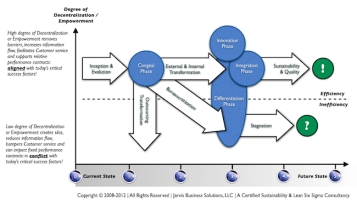“He who is fixed to a star does not change his mind.” ~Leonardo Da Vinci
________________________________
Today’s businesses face a constantly changing landscape that will force closer collaboration between businesses and their community through Sustainability initiatives. Solid partnership between business and community groups will not happen overnight. There are too many changes in strategy, culture, organization and processes. Yet it is a critical shift beyond just environmental considerations to become a key contributor to the value of the community. For those Sustainable Developed strategies, stakeholders must take an active part in strategic planning and day-to-day execution.
Companies will continue to be under pressure to generate value in the Sustainability portfolio that pays the way to operational efficiencies, growth and innovation to increase a competitive advantage. This is only be realized to strong integration that places business value at the center. Collaborative customer centric strategies, supported by Sustainable Develop strategies chosen for the return it will provide, will become the rule rather than the exception. Sustainability will be the model for business in the 21st-century.
The road to these new Business models and strategies is not an easily journey. But neither can it be avoided. Companies that began taking the first steps towards strengthening their business with Sustainability solutions, Business partnerships and move strategically towards tomorrow’s more flexible strategies will be favorably positioned for continued success and growth. Sustainability is an evolutionary process and builds on previous stages of development:
• First, Sustainability is a new mindset and focuses on awareness how resources are used, wastes created and compliance with regulations.
• Second, understanding leads to elimination of waste. This conviction will be a key driver, encouraging optimization of processes as an underpinning to successful Sustainability, reaping costs savings and increased productivity.
• Third, leverage your Sustainability effort to differentiate your products. Build a closer relationship with existing Customers to address their needs and differentiate new products for new customers.
• Fourth, interleave Sustainability throughout your corporate strategies (Operations, IT, Marketing etc) and create a comprehensive single “Sustainability strategy” for both external and internal communities.
• Fifth, promote and refine your aspirational strategies for philanthropy (e.g., breast cancer, military vet programs, diseases, etc), restoration (e.g., wetlands, reforestations, etc.), other social and environmental issues. For those efforts will reflect on your brand image, but remind yourself that continued optimization is ongoing for a Sustainable enterprise, not a one time goal.
________________________________
The 21st century will be Renaissance of Sustainability, it will be the convergence of science, engineering, art and understanding of nature.
______________________________________
Owners, Executive and other Leaders are investigating a global world concerned about Sustainability, that type of understanding can be difficult to obtain. In early December 2013, I published my second book entitled “Building a Bridge to Benefits”. If you are interested in reading about the book or want to purchase copies today, here is the link to CreateSpace, an Amazon company, go to: https://www.createspace.com/4532590
______________________________________
Contact information and Services
A Certified Sustainability and Quality consultancy
• Sustainability and Quality Consulting
• Sustainability and Quality Workshops
• Sustainability and Quality Speaking Engagements
Jarvis Business Solutions, LLC
Toll Free: (888) 743-3128
Email: Ralph.Jarvis@JarvisBusinessSolutions.com
Web site: http://www.JarvisBusinessSolutions.com

